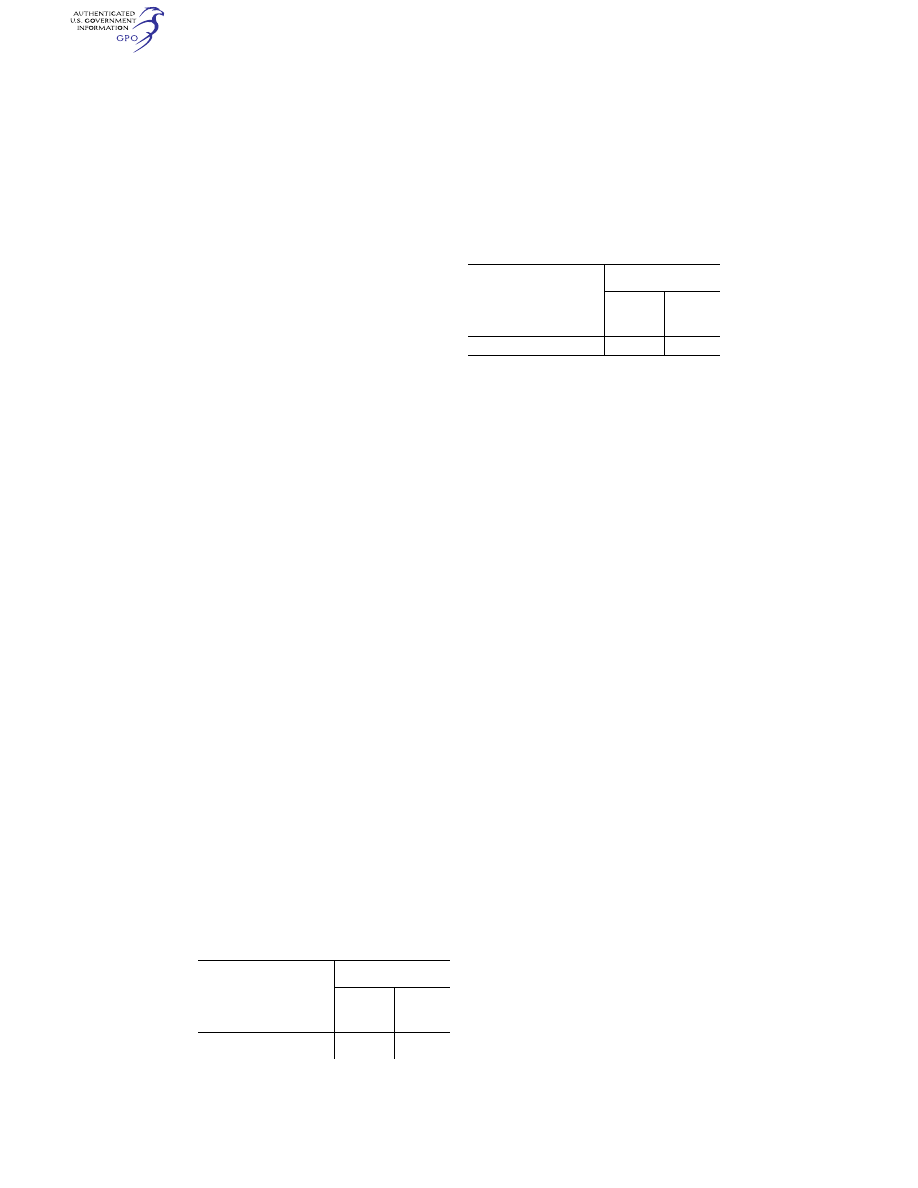
619
Federal Aviation Administration, DOT
§ 29.851
circuit is designed to preclude inad-
vertent battery discharge into charg-
ing circuit faults.
[Amdt. 29–24, 49 FR 44438, Nov. 6, 1984]
§ 29.813
Emergency exit access.
(a) Each passageway between pas-
senger compartments, and each pas-
sageway leading to Type I and Type II
emergency exits, must be—
(1) Unobstructed; and
(2) At least 20 inches wide.
(b) For each emergency exit covered
by § 29.809(f), there must be enough
space adjacent to that exit to allow a
crewmember to assist in the evacu-
ation of passengers without reducing
the unobstructed width of the passage-
way below that required for that exit.
(c) There must be access from each
aisle to each Type III and Type IV exit,
and
(1) For rotorcraft that have a pas-
senger seating configuration, excluding
pilot seats, of 20 or more, the projected
opening of the exit provided must not
be obstructed by seats, berths, or other
protrusions (including seatbacks in any
position) for a distance from that exit
of not less than the width of the nar-
rowest passenger seat installed on the
rotorcraft;
(2) For rotorcraft that have a pas-
senger seating configuration, excluding
pilot seats, of 19 or less, there may be
minor obstructions in the region de-
scribed in paragraph (c)(1) of this sec-
tion, if there are compensating factors
to maintain the effectiveness of the
exit.
[Doc. No. 5084, 29 FR 16150, Dec. 3, 1964, as
amended by Amdt. 29–12, 41 FR 55472, Dec. 20,
1976]
§ 29.815
Main aisle width.
The main passenger aisle width be-
tween seats must equal or exceed the
values in the following table:
Passenger seating capacity
Minimum main passenger
aisle width
Less than
25 inches
from floor
(inches)
25 Inches
and more
from floor
(inches)
10 or less ...................................
12
15
11 through 19 ............................
12
20
Passenger seating capacity
Minimum main passenger
aisle width
Less than
25 inches
from floor
(inches)
25 Inches
and more
from floor
(inches)
20 or more .................................
15
20
1
A narrower width not less than 9 inches may be approved
when substantiated by tests found necessary by the
Administrator.
[Doc. No. 5084, 29 FR 16150, Dec. 3, 1964, as
amended by Amdt. 29–12, 41 FR 55472, Dec. 20,
1976]
§ 29.831
Ventilation.
(a) Each passenger and crew compart-
ment must be ventilated, and each
crew compartment must have enough
fresh air (but not less than 10 cu. ft. per
minute per crewmember) to let crew-
members perform their duties without
undue discomfort or fatigue.
(b) Crew and passenger compartment
air must be free from harmful or haz-
ardous concentrations of gases or va-
pors.
(c) The concentration of carbon mon-
oxide may not exceed one part in 20,000
parts of air during forward flight. If the
concentration exceeds this value under
other conditions, there must be suit-
able operating restrictions.
(d) There must be means to ensure
compliance with paragraphs (b) and (c)
of this section under any reasonably
probable failure of any ventilating,
heating, or other system or equipment.
§ 29.833
Heaters.
Each combustion heater must be ap-
proved.
F
IRE
P
ROTECTION
§ 29.851
Fire extinguishers.
(a)
Hand fire extinguishers. For hand
fire extinguishers the following apply:
(1) Each hand fire extinguisher must
be approved.
(2) The kinds and quantities of each
extinguishing agent used must be ap-
propriate to the kinds of fires likely to
occur where that agent is used.
(3) Each extinguisher for use in a per-
sonnel compartment must be designed
to minimize the hazard of toxic gas
concentrations.
VerDate Sep<11>2014
09:06 Jun 28, 2024
Jkt 262046
PO 00000
Frm 00629
Fmt 8010
Sfmt 8010
Y:\SGML\262046.XXX
262046
jspears on DSK121TN23PROD with CFR

620
14 CFR Ch. I (1–1–24 Edition)
§ 29.853
(b)
Built-in fire extinguishers. If a
built-in fire extinguishing system is re-
quired—
(1) The capacity of each system, in
relation to the volume of the compart-
ment where used and the ventilation
rate, must be adequate for any fire
likely to occur in that compartment.
(2) Each system must be installed so
that—
(i) No extinguishing agent likely to
enter personnel compartments will be
present in a quantity that is hazardous
to the occupants; and
(ii) No discharge of the extinguisher
can cause structural damage.
§ 29.853
Compartment interiors.
For each compartment to be used by
the crew or passengers—
(a) The materials (including finishes
or decorative surfaces applied to the
materials) must meet the following
test criteria as applicable:
(1) Interior ceiling panels, interior
wall panels, partitions, galley struc-
ture, large cabinet walls, structural
flooring, and materials used in the con-
struction of stowage compartments
(other than underseat stowage com-
partments and compartments for stow-
ing small items such as magazines and
maps) must be self-extinguishing when
tested vertically in accordance with
the applicable portions of appendix F
of Part 25 of this chapter, or other ap-
proved equivalent methods. The aver-
age burn length may not exceed 6
inches and the average flame time
after removal of the flame source may
not exceed 15 seconds. Drippings from
the test specimen may not continue to
flame for more than an average of 3
seconds after falling.
(2) Floor covering, textiles (including
draperies and upholstery), seat cush-
ions, padding, decorative and non-
decorative coated fabrics, leather,
trays and galley furnishings, electrical
conduit, thermal and acoustical insula-
tion and insulation covering, air duct-
ing, joint and edge covering, cargo
compartment liners, insulation blan-
kets, cargo covers, and transparencies,
molded and thermoformed parts, air
ducting joints, and trim strips (decora-
tive and chafing) that are constructed
of materials not covered in paragraph
(a)(3) of this section, must be self ex-
tinguishing when tested vertically in
accordance with the applicable portion
of appendix F of Part 25 of this chapter,
or other approved equivalent methods.
The average burn length may not ex-
ceed 8 inches and the average flame
time after removal of the flame source
may not exceed 15 seconds. Drippings
from the test specimen may not con-
tinue to flame for more than an aver-
age of 5 seconds after falling.
(3) Acrylic windows and signs, parts
constructed in whole or in part of
elastometric materials, edge lighted
instrument assemblies consisting of
two or more instruments in a common
housing, seat belts, shoulder harnesses,
and cargo and baggage tiedown equip-
ment, including containers, bins, pal-
lets, etc., used in passenger or crew
compartments, may not have an aver-
age burn rate greater than 2.5 inches
per minute when tested horizontally in
accordance with the applicable por-
tions of appendix F of Part 25 of this
chapter, or other approved equivalent
methods.
(4) Except for electrical wire and
cable insulation, and for small parts
(such as knobs, handles, rollers, fas-
teners, clips, grommets, rub strips, pul-
leys, and small electrical parts) that
the Administrator finds would not con-
tribute significantly to the propaga-
tion of a fire, materials in items not
specified in paragraphs (a)(1), (a)(2), or
(a)(3) of this section may not have a
burn rate greater than 4 inches per
minute when tested horizontally in ac-
cordance with the applicable portions
of appendix F of Part 25 of this chapter,
or other approved equivalent methods.
(b) In addition to meeting the re-
quirements of paragraph (a)(2), seat
cushions, except those on flight crew-
member seats, must meet the test re-
quirements of Part II of appendix F of
Part 25 of this chapter, or equivalent.
(c) If smoking is to be prohibited,
there must be a placard so stating, and
if smoking is to be allowed—
(1) There must be an adequate num-
ber of self-contained, removable ash-
trays; and
(2) Where the crew compartment is
separated from the passenger compart-
ment, there must be at least one illu-
minated sign (using either letters or
symbols) notifying all passengers when
VerDate Sep<11>2014
09:06 Jun 28, 2024
Jkt 262046
PO 00000
Frm 00630
Fmt 8010
Sfmt 8010
Y:\SGML\262046.XXX
262046
jspears on DSK121TN23PROD with CFR

